When your reef tank has been up and running for a while and you begin to add more corals, testing will begin to show that the key elements of calcium, carbonate and magnesium are slowly depleting.
You can add solutions of these elements manually but that is both time-consuming and prone to error.
So, it’s now time to automate the process by using a reef tank dosing pump.
Let’s take a look at the best ones…
Table of Contents
Top 5 Dosing Pumps For Reef Tanks
| # | Preview | Product | Quick Review |
| 1 | 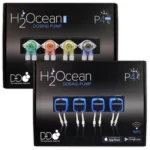 | DD H2Ocean P4 Dosing Pump | Best Overall |
| 2 | 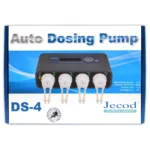 | Jeboa Jecod DS-4 Auto Dosing Pump | Cheap but not accurate enough |
| 3 | 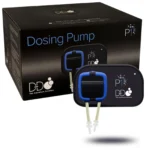 | DD H2Ocean P1 Dosing Pump | Great Single Pump |
| 4 | 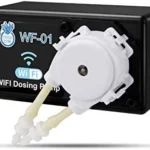 | Coral Box WIFI Dosing Pump | Inferior Quality |
| 5 | 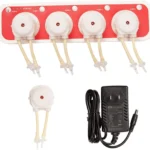 | YING-pinghu WiFi Dosing Pump | Cheap knock-off copy |
Why You Should Use A Reef Tank Dosing Pump
As the key elements of calcium, carbonate and magnesium are consumed by coral and invertebrates they will slowly deplete in your reef tank and you will need to replace them by adding chemical supplements.
A reef tank dosing pump is simply a peripatetic style pump that will dose a set amount of your chemical supplements at a set time.
Once you have established how much of each element your tank is using on a daily or weekly basis you can determine how much you need to dose of each element and how frequently
Whilst you can add these manually, it is far easier and more accurate to use a programmable pump to automate the process.
Using a dosing pump means you can spread the dosing throughout the day or week which is more natural for your corals and means you are less likely to see swings in water parameters.
(For the best dosing supplements to use see our guide on the Best Reef Tank Dosing Supplements.)
What to Look for When Buying a Reef Tank Dosing Pump
Accuracy – Accuracy and consistency is the most important consideration in a dosing pump. After all, it’s not much use if you have worked out that you want to dose 20ml of your calcium supplement each day, only to find your pump only adds 10ml or overdoses 30ml.
Flexibility– You will need to be able to dose multiple times throughout the day or week and with differing amounts. The pump should be able to be calibrated and have a manual addition option.
Ease of Use – Whether controlled manually or via wi-fi, the software needs to be easy to use, simple to understand and robust.
Scalability – If you decide to add more dosing options, for coral feeding, for example, are there enough heads and dosing channels, or can you add easily add additional pumps.
Dosing Pumps For Reef Tanks Product Reviews
Here are my reviews of the best dosing pumps for reef tanks products:-
1. DD H2Ocean P4 Dosing Pump
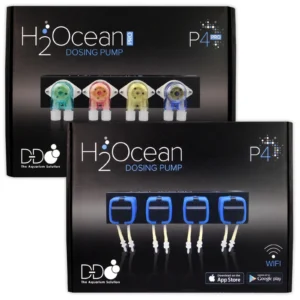
The H2Ocean P4 Dosing Pump comes in two models, standard and PRO. Both have been jointly developed with Kamoer to medical grade precision.
Both have 4 dosing heads so you can dose the key elements, calcium, alkalinity and magnesium from 3 heads leaving one spare for something else.
The ‘P4 PRO’ version uses direct-drive geared DC motors for even greater dosing accuracy and precision. The PRO also includes colour coordinated heads and tubing.
Both models of the dosing pump are controlled by the H2Ocean Dosing App from your mobile device. Functions include:-
- Pump selection and naming.
- Channel setting and dosing volumes.
- Flow calibration.
- Display of elements and dosing volumes.
- Monitors the amount of liquid remaining in each dosing container.
- Simple quick setup/stop/start functions.
- 1 – 12 dosing times per day (Pro version 1 – 24)
- Daily/every “x” days specified days of week Dosing Frequency
- Manual dosing options
- Fluid Volume: 0.1ml – 9,999ml
- Accuracy: P4 <+/-2%; P4 PRO version <+/-0.5%
DD H2Ocean P4 App

This screen shows the overall plan control for each pump. (The pumps have been renamed to clearly show which dosing solution applies).
This also shows the total amount set to dose each day and the remaining days left until your dosing container is empty.

This screen shows, for each pump, how often and how much the pump doses and at what times.
You can set each pump to dose up to 12 times per day (24 for the Pro version).
You can also set the the total volume of the solution in your dosing container.
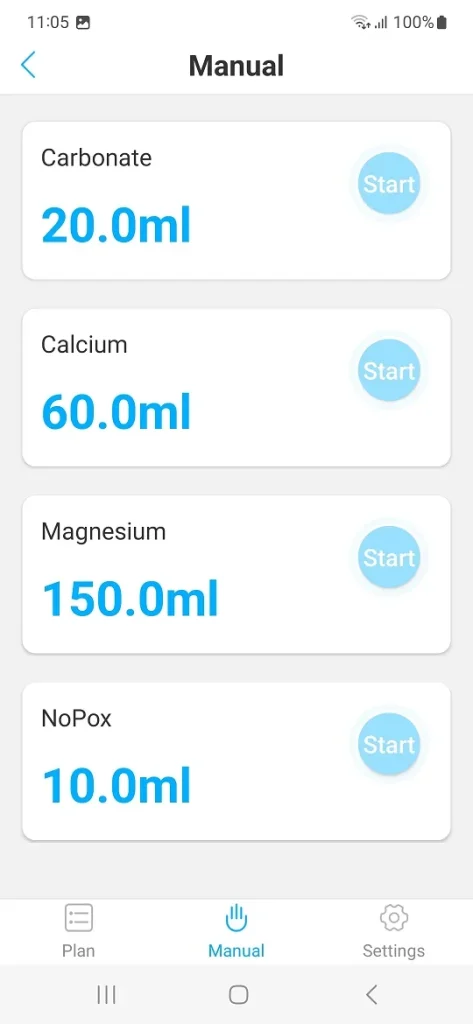
From this screen you can manually set a fixed amount to dose and the pump will dose it immediately.
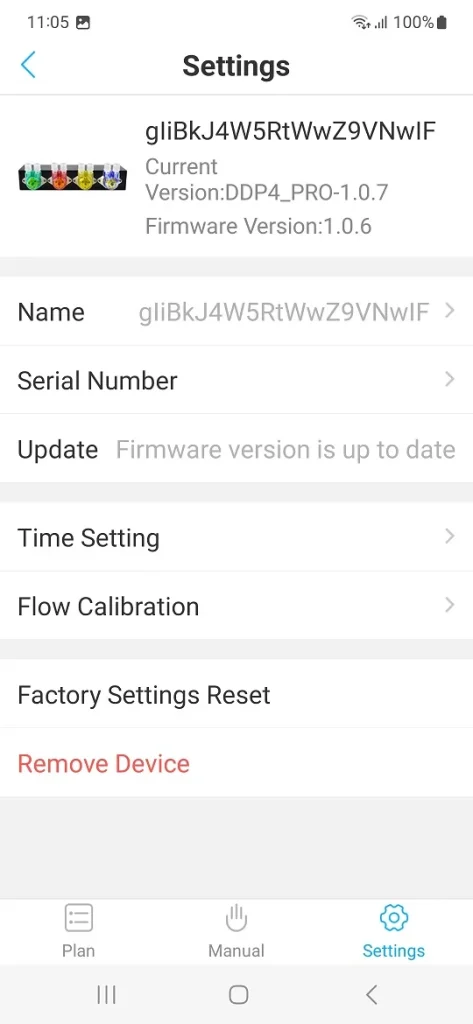
The device settings allow you to update the firmware and calibrate each pump.
The DD H2Ocean P4 App is both easy to set up and use. Be sure to calibrate each pump on first use to ensure the best performance and accuracy.
Pros
- Wi-fi control
- Android and IOS
- Small Footprint
- Huge Dosing Flexibility
- Very Accurate
- Robust Heads
- Battery Backup
Cons
- None
2. Jeboa Jecod DS-4 Auto Dosing Pump
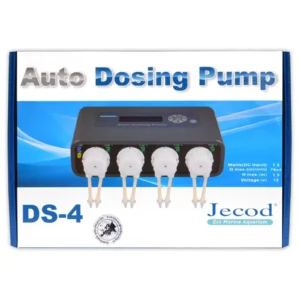
The Jecod DS-4 Auto Dosing Pump can be considered an entry-level dosing pump and comes with either 2, 3 or 4 dosing heads. You can also add a further 4 dosing heads by adding an additional slave unit controlled by the original ‘master’.
The pumps are controlled manually, via an electronic control panel on the side or top of each unit. Whilst easy enough to use, this can be a problem once it is fixed in place in your sump.
Number of doses per day (per pump) 1 – 24
Interval of days for dosing 0 – 30 days (0 = no dose, 1 is every day, etc,)
Dosing volume per dose 1 – 9999ml
Pros
- Entry Level
- Cheap
- Can add a slave unit
- Battery Backup
Cons
- Manual Control (No wi-fi)
- Basic Software
- Fiddly to Program and Calibrate
- Not Accurate Enough
- Cheap Plastic Heads
- No Supplied Tubing
3. DD H2Ocean P1 Dosing Pump
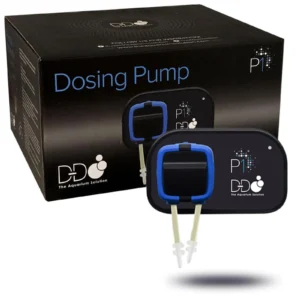
The H2Ocean P1 Dosing Pump is a great single head pump that has all the accuracy and controllability of the P4 above.
You can use the Daisy chain DC cable to connect to another P1 dosing pump or string of pumps.
Best used as an addition to the P4 if you only want to add one or two more dosing channels.
Pros
- Wi-fi control
- Android and IOS
- Small Footprint
- Very Accurate
- Daisy chain additional P1 dosing pumps
Cons
- Cheaper to buy the P4 than 4 x P1
4. Coral Box WIFI Dosing Pump
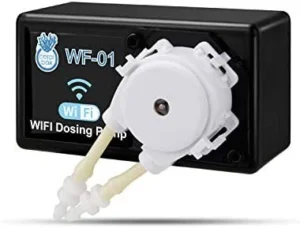
The Coral Box WIFI Dosing Pump a single-head pump for dosing with wi-fi for control via a smartphone.
However, the build is of a flimsy quality and the pump is unlikely to be accurate enough for reef tank dosing.
Flashing alarm if there is a lack of liquid or breakdown.
Pros
- Wi-fi control
Cons
- Flimsy build quality
- Inaccurate
- Can’t daisy chain additional pumps
5. YING-pinghu WiFi Dosing Pump
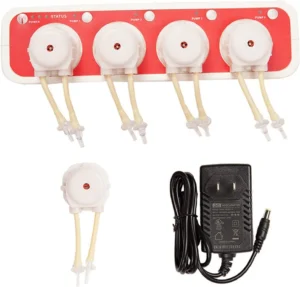
The YING-pinghu WiFi Dosing Pump is typical of the cheap Chinese knock-offs that you will see listed online.
Whilst they may work (initially) they are of such poor quality that they are likely to cause more harm than good.
They are not even that cheap. Avoid.
Pros
- None
Cons
- Everything – Avoid
Conclusion
The H2Ocean P4 Dosing Pump is our choice for ‘best overall’ dosing pump for reef tanks and is a comfortable winner, particularly the PRO version. The ease of Wi-fi control and the pump’s accuracy and flexibility mark it out as a great piece of kit.
Dosing accuracy is probably the most important thing when looking at dosing pumps for reef tanks and H2Ocean P4 PRO Dosing Pump is the best out there for this.
For the best dosing supplements to use see our guide on the Best Reef Tank Dosing Supplements.
Dosing Pump for Reef Tanks FAQs
Is dosing necessary for a reef tank? – Yes, corals use calcium and carbonate to grow their skeletons and will therefore deplete these chemical elements in our reef tank water over time.
We replace them by dosing suitable chemical supplements.
When should I start dosing my reef tank? – As soon as you start to add corals you should regularly test the level of calcium, carbonate and magnesium in the water.
When they start to drop you know it is time to start dosing.
How much do I dose in a reef tank? – By doing regular testing you need to establish which elements are being used up, how quickly, and by how much. Then make a schedule of how much to dose each element on a daily or weekly basis.
Remember, it’s better to divide the total into smaller amounts and spread your dosing throughout the day rather than dump the whole amount in at once.
Where should I set up my dosing pump? – The best place to put a dosing pump is in the sump cabinet with the output tubes running directly to the return pump chamber.
The tubes should be above the water and held in place by a holder. Do not have them actually in the water as this could cause a back-siphon of tank water into your dosing containers.
Your dosing supplement containers should be lower than the outlet tube end coming from the reef tank doser. Again, this will ensure that a siphon isn’t created.
How do I set up the dosing schedules? – follow the instructions that come with the reef tank dosing pump to set the dosing schedules.
